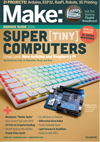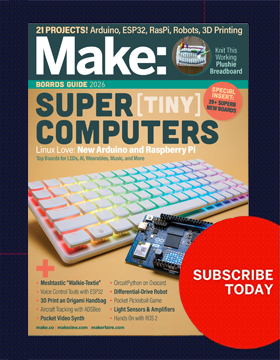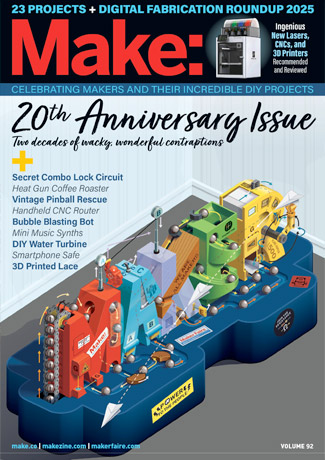Patrick Houston is a veteran technology editor and online publishing executive. He is a former editor-in-chief of CNET, and he led the team that launched Yahoo Tech. He is also a media entrepreneur who believes the Maker Movement is at the cutting edge of a new economic epoch that will thrive on inventors, startups, and the 'micro-enterprise.'
View more articles by Patrick HoustonPaul Clinton started out 19 years ago as a shop teacher. Now he’s an “engineering technology” educator, a title bestowed on him by his Colorado school district that made a commitment to STEM education 15 years ago. Using his high school’s well-equipped fab lab to give his pupils hands-on learning experiences is his chief goal. But it’s not his only one.
He wants to make sure they understand that all those store shelves they see aren’t stocked with items that appeared out of thin air. So he’s having his students carve a clever mold on a CNC machine to make pewter parts and learn how manufacturing works. Here he shares step-by-step instructions for making a student-designed paperweight.
“Students in general have a big disconnect with exactly how products are made,” he says. “A lot of products involve molds.”

Clinton, 41, is among a growing cohort of educators retooling their shop classes, vocational education, and industrial arts programs into those that recognize the new realities shaping the economy and the work skills it demands.
He works at one of seven high schools in the Cherry Creek School District near Denver. While many schools have only recently embraced STEM, Cherry Creek students have had access to fab labs for several years. according to Jay Moore, the district’s Career and Technical Education Coordinator.
Several years is right. A decade ago, Moore was a district teacher who introduced 3D printing to his high school when machines cost $40,000 and loomed as large as a refrigerator.
Cherry Creek’s commitment wasn’t just ahead of the times. It goes down to the community’s grassroots. Proof: Four years ago, as part of the district’s ongoing STEM emphasis, voters there approved a $125 million bond issue, largely earmarked to support STEM curriculum, expand its facilities, and add to their already well-equipped fab labs.
Classes at the 56,000-student suburban district certainly don’t sound like those of old. Clinton’s Cherokee Trail High offers 11 different courses, such as Architectural Design, Computer-aided Design, Pre-engineering Technology, Robotic Technologies, and even one called Medical & Sustainable Technologies.
What’s more, those courses take place in fab labs at each high school equipped with tools such as laser cutters, large-format routers, 3D printers, Roland vinyl cutters, Roland UV-LED printers, and Roland benchtop CNC milling machines. Cherry Creek owns some 10 Roland benchtop milling machines, because they’re easy, safe, and forgiving, according to Clinton, CTE Coordinator Moore, and other teachers there.
Cherry Creek begins introducing its fab-lab projects to students starting in their freshman year. But it’s less about teaching them tools and more about teaching them how to prototype, a skill that will make them far more marketable over the long haul.
Clinton’s pewter casting project does just that.
It takes students through the steps of designing and creating a pewter key fob, pendant, or in this particular case, a paperweight commemorating Colorado and its capitol city.
The project achieves two things, Clinton says: It introduces students to the Roland MDX 540 and the Roland MDX 40A in his fab lab, and it allows them to understand molding — especially thinking through how material must flow to all parts of the form.
Clinton says it takes about seven class periods to complete — he teaches software and other skills along the way — and requires only a few basic materials: Some pewter, talcum powder, two 5″×5″ squares of medium-density fiberboard (MDF), clamps, and handtools for finishing.
Clinton uses lead-free pewter he buys in one-pound ingots from Amazon for about $27. One ingot is enough for a class of 16 students, he says.
Here’s the step-by-step process for his project:
Step 1. Hand sketch a design.
Clinton doesn’t put any boundary on his students’ imaginations. He does, however, put a limit on the size of their creation to economize on material. This project represents how one of his students, 17-year-old junior Henry Kvietok, designed the paperweight. The design is a “C” for Colorado with the Denver skyline in the background.
Step 2. Convert the sketch into an STL file.
For this, Clinton teaches the students to use SolidWorks, the CAD/CAM software highly popular among schools.
Step 3. Convert the STL file into a Roland SRP file.
Alan Rydlund, another Cherry Creek engineering technology teacher, says the easy-to-use SRP software that comes with Roland mills actually changes his emphasis. “I don’t teach projects as a milling class but as a prototyping class,” he says.
Step 4. Attach two-sided tape to one of the 5″× 5″ MDF squares.
The two-sided tape provides enough adhesion to hold the MDF in place in the Roland MDX 40A CNC mill used for this project.
Step 5. Place the square in the Roland CNC to create the negative.
Clinton extols the Roland DGA MDX CNC mills as particularly good for inexperienced and inattentive teens. Plus, he says the mills have proven to be highly reliable. Rydlund says he’s had to keep an eye on other mills while they’re running — a challenge because some projects can take so long. “I can let the Roland machines run overnight,” he says, without having to worry if a job will run afoul.
Step 6. Coat both sides of the MDF mold with talcum powder.
Spread it with a brush. The talcum — you can use baby powder too — serves as a mold release.
Step 7. Clamp the sides together.
As you can see from the picture, the project uses three clamps, to make certain the form’s front and back stay tightly together to reduce flashing — edge seepage that has to be removed.
Step 8. Pour the pewter into the mold.
Clinton encourages his students to do each step, but since some are reluctant to deal with hot metal, he readily will do this one for them.
Step 9. Take the mold apart and remove the casting.
Make sure the part has cooled sufficiently — about 20 minutes.
Step 10. Finish the molded part with files and other tools. “The kids absolutely love this project,” Clinton says. “They’ve never been exposed to molten metal, and it’s something they can have for the rest of their lives.”
Cherokee Trails High student Henry Kvietok actually made two paperweights for his project. Here’s a look at his finished project.
He says he plans to keep one for himself and give the other as a gift for his father. But what the younger Kvietok received may be the best gift of all. “I really enjoyed the project because I got to take a unique conceptual design and turn it into an actual product,” he says. “I felt accomplished because the mold worked out how I planned.”
About the sponsor: Roland DGA Corporation serves North and South America as the marketing, sales and distribution arm of Hamamatsu, Japan-based Roland DG Corporation. In addition to offering a wide variety of advanced digital products for the sign, personalization, rapid prototyping, part manufacturing and the medical and dental CAD/CAM industries, Roland DGA is also committed to supporting STEM programs in partnership with specialized distributors throughout the United States, providing curriculum, equipment, training and support.
What will the next generation of Make: look like? We’re inviting you to shape the future by investing in Make:. By becoming an investor, you help decide what’s next. The future of Make: is in your hands. Learn More.
Patrick Houston is a veteran technology editor and online publishing executive. He is a former editor-in-chief of CNET, and he led the team that launched Yahoo Tech. He is also a media entrepreneur who believes the Maker Movement is at the cutting edge of a new economic epoch that will thrive on inventors, startups, and the 'micro-enterprise.'
View more articles by Patrick HoustonADVERTISEMENT

















